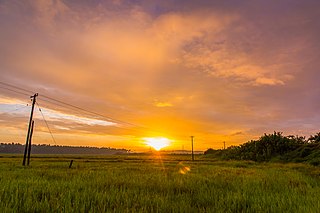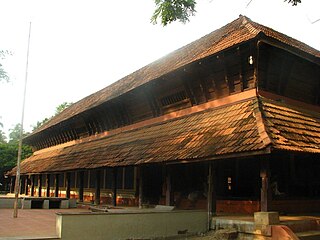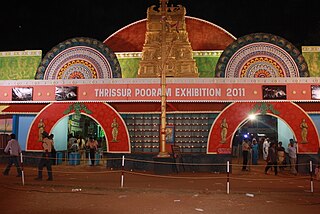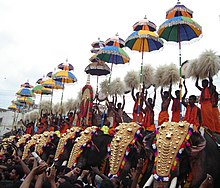
Thrissur, formerly Trichur, also known by its historical name Thrissivaperur, is a city and the headquarters of the Thrissur district in Kerala, India. It is the third largest urban agglomeration in Kerala after Kochi and Kozhikode, and the 21st largest in India. The city is built around a 65-acre (26 ha) hillock called the Thekkinkaadu Maidaanam which seats a large Hindu Shiva Temple. It is located 304 kilometres (189 mi) north-west of the state's capital city, Thiruvananthapuram. Thrissur was once the capital of the Kingdom of Cochin, and was a point of contact for the Assyrians, Greeks, Persians, Arabs, Romans, Portuguese, Dutch and English.

Pooram pronounced is an annual festival, which is celebrated in temples dedicated to goddesses Durga or Kali, held especially in the old Valluvanad area, and to a lesser extent in other places, covering Kerala State's present-day Palakkad, Thrissur and Malappuram districts) as also Kollam district, after the summer harvest. Harimattom pooram is one of the famous pooram in Ernakulam. An example of a famous pooram is Thirumandhamkunnu Pooram which has an active participation of 11 Lakh people across the country. Most pooram festivals have at least one ornately decorated elephant being paraded in the procession taken out of the temple precincts. However, there are some well known poorams, such as Anthimahakalankavu Vela, Chelakkara, Aryankavu Pooram at shoranur Palakkad and Machad mamangam near Wadakkanchery that do not use the caparisoned elephant, instead go for stilted mannequins of horses or bullocks. Vela is also a festival like pooram. Thrissur Pooram is the most famous of all poorams, known for fire works. The second-best-known Pooram in Kerala is Kollam Pooram. Kavassery pooram is well known for fireworks during afternoon. Some other well-known pooram festivals are Arattupuzha-Peruvanam Pooram, Chalissery Pooram is well known for the art and cultural standards, Anthimahakalankavu Vela, Nenmara Vallangi Vela, Vairankode Vela, Chinakathoor pooram, Mannarkkad Pooram, Kavassery Pooram, Pariyanampatta Pooram, Harimattom Pooram and Thirumandhamkunnu Pooram. Peruvanam-Arattupuza pooram is celebrating its 1436th year in 2018.

The ThrissurPooram is an annual Hindu temple festival held in Thrissur, Kerala, India. It is held at the Vadakkunnathan (Shiva) Temple in Thrissur every year on the Pooram day—the day when the moon rises with the Pooram star in the Malayalam Calendar month of Medam. It is the largest and most famous of all poorams in India. Thrissur pooram is also one of the largest festivals in Asia with more than 1 million visitors.

The Guruvayur Temple is a famous Indian Hindu temple located in the town of Guruvayur in Thrissur district, Kerala. The temple is dedicated to Lord Vishnu (Guruvayurappan) but popularly known as Krishna. It is one of the most important places of worship for Hindus in Kerala and Tamil Nadu and is often referred to as Bhuloka Vaikuntha. The temple is Classified one among the 108 Abhimana Kshethram of Vaishnavate tradition.

Cherpu is a suburb of Thrissur city in the Kerala State of South India. It is 12 kilometres south of Thrissur town and is on the Thriprayar road. It is dotted by a number of temples and has quite a few rivers flowing by its vicinity.

Thrissur, anglicised as Trichur, is one of the 14 districts in the Indian state of Kerala. It is situated in the central region of the state. Spanning an area of about 3,032 km2 (1,171 sq mi), the district is home to over 9% of Kerala's population.

Punnathurkotta is a fort and former palace located in Kottapadi, about 3 km from the Guruvayoor Sree Krishna Temple, in Thrissur District of Kerala State in South India.

Temple elephants are a type of captive elephant. Many major temples own elephants; others hire or are donated elephants during the festive seasons. Temple elephants are usually wild animals, poached from the forests of North East India from wild herds at a young age and then sold into captivity to temples. Their treatment in captivity has been the subject of controversy and condemnation by some, while others claim that elephants form a vital part of the socio-economic framework of many temple ceremonies and festivals in India, particularly in the South.

Thiruvambadi Sri Krishna Temple is a Hindu temple in the city of Thrissur in Kerala, India. The main deities of this temple are Krishna in the form of a child, and Bhadrakali, both having equal importance. There are sub-shrines for Ganesha, Sastha and Brahmarakshasa, and there is a sub-temple for Ganesha behind the temple. The temple is one of the two rival groups participating in the Thrissur Pooram.

Paramekkavu Bagavathi Temple is one of the largest Bagavathi temples in Kerala located in Thrissur City. Sakthan Thampuran ordained the temples into two groups, namely "Paramekkavu side" and "Thiruvambady side" for Thrissur Pooram which is the biggest festival in South India and Kerala. These two groups are headed by the principal participants, Paramekkavu Bagavathi Temple at Thrissur Swaraj Round and Thiruvambadi Sri Krishna Temple at Shoranur road. The two temples are hardly 500 metres apart. Thiruvambadi Sri Krishna Temple is one of the two groups participating in Thrissur Pooram. The Paramekkavu temple devaswom have a school known as Paramekkavu Vidya Mandir at MLA road near Kutoor and one KG section near to the temple itself.

Kerala which is often referred to as 'God's Own Country' has many Hindu temples. Many of the temples have unique traditions and most hold festivals on specific days of the year. Temple festivals usually continue for a number of days. A common characteristic of these festivals is the hoisting of a holy flag which is then brought down only on the final day of the festival. The largest festival in kerala in Pooram category is Arattupuzha Pooram at Arattupuzha temple and in Ulsavam category is Vrishchikolsavam of Thripunithura Sree Poornathrayeesa Temple. Some festivals include the most famous of these being the Thrissur Pooram. Temples that can afford it will usually involve at least one richly caparisoned elephant as part of the festivities. The idol of the God in the temple is taken out on a procession around the countryside atop this elephant. When the procession visits homes around the temple, people will usually present rice, coconuts and other offerings to the God. Processions often include traditional music such as Panchari melam or Panchavadyam. The festivals of Kerala are famous around the Globe due to its diversity of experience.

The oldest pooram in all of Kerala, the Arattupuzha Pooram is held at the Sree Sastha Temple in Thrissur for a period of seven days each year. Believers say that at this 'conclave', all Gods and Goddesses gather during the time period of the Pooram. Arattupuzha Temple in Arattupuzha, Thrissur district of Kerala. Visitors from nearby and far off places reach the village of Arattupuzha during the festival days. The pinnacle of the seven-day festival is the last two days. The evening prior to the last day of the festival would have an assembly of caparisoned elephants and staging of percussion ensembles as part of the ceremony called Sasthavinte Melam. The pancharimelam of Aarttupuzha Sasthavu is the largest assembly of percussion artists in any other night Poorams. More than 200 artists perform in sasthavinte melam. This can only be seen at Sree Poornathrayeesa Temple, Tripunithura other than in Arattupuzha Pooram

Peruvanam Pooram is one of the most popular temple festivals of the South Indian state of Kerala. It is held at Peruvanam Temple in Cherpu, Thrissur District. Lord Shiva is the presiding deity of this temple.

Uthralikkavu Pooram (ഉത്രാളിക്കാവ്) is a festival held at Shri Rudhiramahakalikav temple situated at Wadakkanchery in Thalappilly taluk of Thrissur district in Kerala, South India. The temple is famed for its Pooram festival held during February / March every year. It is considered as the second highest crowded pooram after Thrissur Pooram

Peruvanam Kuttan Marar is a chenda artist. He leads several popular traditional orchestra performances in Kerala. He received Padma Shri, India's third highest civilian award, in 2011 for his contributions in the field of art.

All India Agricultural, Industrial, Educational and Cultural Exhibition or commonly called the Thrissur Pooram Exhibition is an exhibition organised jointly by Paramekkavu Bagavathi Temple Devaswom and Thiruvambadi Sri Krishna Temple Devaswom, ahead of Thrissur Pooram in Thekkinkadu Maidan in Thrissur city. It is usually conducted over a period of 40 to 50 days during the Thrissur Pooram.The exhibition is the largest in Kerala in terms of attendance and floor space.
Gods in Shackles is a 2016 Indian investigative drama feature-length documentary film written, directed and executive produced by Sangita Iyer on her documentary directorial debut. The documentary is based on the captive elephants in Kerala culture and inspired by the filmmaker's own personal experience witnessing the torture and suffering faced by the temple elephants during cultural festivals. The documentary was screened at the Legislative Assembly of Kerala on 21 May 2016 following a suggestion by speaker P. Sreeramakrishnan, who formally approved the release.
Paramekkavu Rajendran was an elephant from Kerala, who holds the record of participating in the most number of Thrissur Poorams for more than 50 years.

Abhayaranyam is an animal shelter–mini zoo, which functions under the eco-tourism project of Kerala government. Located near to Kaprikad village in Kunnathunad taluk of Ernakulam district, the shelter was opened in 2011, with an aim to rehabilitate the animals in the Kodanad elephant training center, located two kilometers away. Kodanad Elephant training center was one of renowned and largest elephant training center in Kerala. It was also the first elephant training center in Kerala, started in 1895. The center covered an area of 2 acres and when the number of animals there kept increasing, all the animals were gradually relocated to Abhayaranyam, which has an area of 123 hectares.





















